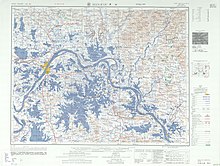Hsi-shui
Jump to navigation
Jump to search
English
[edit]
Etymology
[edit]From Mandarin 浠水 (Xīshuǐ) Wade–Giles romanization: Hsi¹-shui³.
Proper noun
[edit]Hsi-shui
- Alternative form of Xishui
- 1969, FAO Agricultural Services Bulletin[2], numbers 35-40, →ISSN, →OCLC, page 24:
- The seventh rice mill visited is run by a brigade located in the October People's Commune in Hsi-shui County, Hupei Province. It is an old mill built, it would appear, with local material but adopting all the modern essential equipment.
- 1992, Edwin Pak-wah Leung, WEN I-TO (Historical Dictionary of Revolutionary China, 1839-1976)[4], Greenwood Press, →ISBN, →LCCN, →OCLC, page 461:
- Wen I-to was the eldest son of a renowned scholar family of Hsi-shui County in Hupei Province. At an early age he was trained in the classics by a disciplinarian father, and at then he was sent to Wuchang (a day's trip from Hsi-shui) to study at a modern grade school.
Translations
[edit]Xishui — see Xishui